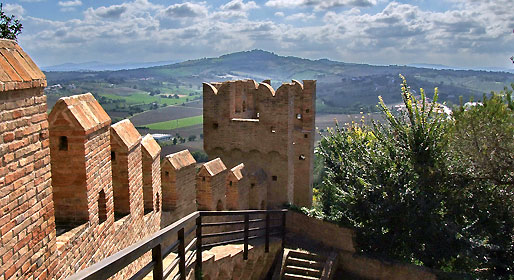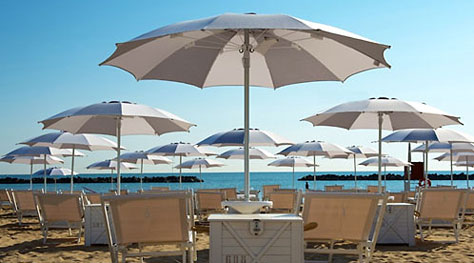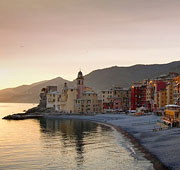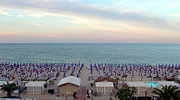Mad about the Marche
Hanging out in the hilltop towns and Renaissance cities of Italy's Marche.
High on the hills bordering the Marche and Romagna, and not far from the Republic of San Marino, the village and Castle of Gradara is the most important stronghold in the province of Pesaro.
This ancient stronghold close to the sea and which, in the summer months, stays open to the public until late in the evening, boasts some 14 towers, a beautiful internal portico, a magnificent staircase and the most sumptuous of frescoed banqueting and reception halls.
In medieval times, the castle provided the stage on which every genre of dispute and passion were consumed: the most famous of which being the ill-fated love affair between Paola Malatesta and Francesca da Polenta (the unhappy bride of his brother), immortalized by the great Dante Alighieri in his Divine Comedy (Inferno, Canto V).
In this band of hills close to the Adriatic sea and not far from Montefeltro, you'll find castles but also any number of charming farm stays and country guesthouses, in which to enjoy genuine local food and wine and experience a taste of life in rural Marche
Pesaro's castle and composer
Pesaro, the second largest city in Marche after the regional capital of Ancona, and only a few kilometers from the fashionable seaside town of Rimini, is dominated by the castle which stands right in the center of the city.
The Rocca Costanza, a massif square edifice with four immense cylindrical towers and surrounded by a wide ditch, is situated just a few blocks away from Casa Rossini: another of the city's landmarks.
This is the house (now transformed in museum) where the celebrated composer of the Barber of Seville, Gioacchino Rossini, was born: artist to whom the annual Rossini Opera Festival is dedicated.
Despite being one of the most important economic centers in the region, Pesaro is a surprisingly peaceful little city, and its seaside promenade and historic center can quite happily be explored on foot or by bike
Among the city's most significant works of architecture we find the Palazzo Ducale, erected by Alessandro Sforza, the late 15th century Imperial Villa, and the Synagogue.
The Malatesta in Marche
Little more than ten kilometers lie between Pesaro's Rocca Costanza and Fano's Rocca Malatestiana. Testifying further to the presence of the powerful family in Fano, the Malatesta Court, just steps away from the 14th century Palazzo del Podestà in the central Piazza XX Settembre, is an elegant edifice now used as venue for concerts and theatrical performances.
Those eager to experience the peace and tranquility of the hillside of the Marche, should make the trip to the Hermitage of Monte Giove, just beyond the walls of Fano. From the convent's panoramic terrace a marvelous view of the town, the Metauro Valley, and the sea can be seen.
Contemporary art in Fossombrone
From Fano we travel just a few kilometers inland so as to reach Fossombrone. The streets of this picturesque little town hugging the hillside, abound with antiquities, churches, and elegant patrician residences.
Not to be missed: a visit to the Casa Museo Quadreria. This bold work of modern architecture and design donated to the town by Giuseppe Cesarini contains a prestigious art collection with paintings by Giorgio Morandi, Arturo Tosi and other highly acclaimed 20th century artists.
Renaissance riches in Urbino
The beautifully conserved historic center of Urbino is more than worthy of its status as UNESCO World Heritage Site.
Despite the passing of the centuries, the charm of the ancient capital of the dukedom of Montefeltro has remained intact. If anything, the beauty of the city has been increased, by the addition of the meticulously cared for vineyards which now carpet the surrounding hills.
Urbino's finest renaissance artworks can be seen in the city's Palazzo Ducale, an imposing 15th century edifice, now seat of the National Gallery of the Marche.
Piero della Francesca's "Flagellation of Christ" and "Madonna of Senigallia", and Raphael's "Portrait of Young Woman" are, perhaps, the best-known of the 15th century masterpieces on show
The ghost of Count Cagliostro
Proceeding northwards, we are greeted by the spectacular sight of the small village of San Leo, built on the cliffs overlooking the valley of the river Marecchia.
Perched perilously on a rocky spur, the town's fortress, now home to a Museum and impressive art collection, is linked to the mysterious figure of Count Cagliostro, the alchemist who claimed to have discovered the elixir of eternal youth and, for his audacity, was promptly sentenced to death by the Inquisition. Cagliostro was imprisoned in the castle of San Leo, where he died in 1795.






















